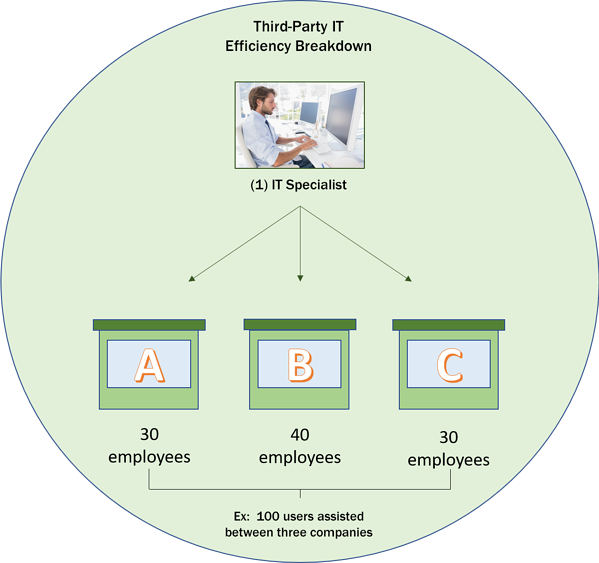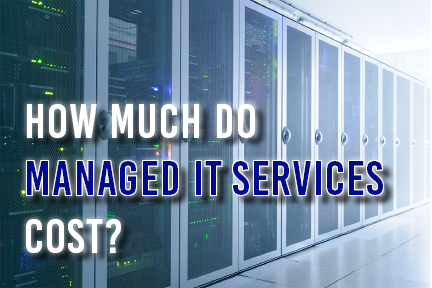IT SERVICES COST | 19 MIN READ
We get it. It can be frustrating to be looking for the price of a service only to get the run-around, or worse, feel like the information you're reading is slanted to get you to buy from a particular company. We hear you loud and clear and have updated our article to include even more detail than before so that we completely answer the question of how much managed IT services cost.
Before we can dive into helping you understand the different managed IT services cost models, we need to define what “managed IT services” is, because for those not in the IT industry, it’s easy to get bogged down with all the technical jargon.
Managed IT Services is a broad term for an external IT company that manages some or all of your IT operations, ranging from network security, to scheduling system updates, to back-up and disaster recovery, and more.
Hiring managed IT services can save your company money by thwarting data breaches. According to a 2017 report sponsored by IBM from the Ponemon Institute, a single data breach costs a company $3.6 million, with the average cost per stolen record being $141.
After doing some initial research on a variety of companies, you might find that when you ask “How much does it cost to outsource IT support?”, no one wants to give you a price when you inquire about service rates! The truth is that every company’s IT needs vary. Pricing isn't as simple as just quoting a flat rate if it is done correctly.
By the end of this article, you will be able to understand nearly all the contributing cost factors and subsequent price ranges for managed IT services. We hope we can serve as a resource to propel your company down a path to success.
That is why in this article, we include our free managed IT services cost calculator to help you visualize how much managed IT services might cost your company.
Not a lot of time? Skip to:
IT Services Cost Guide
Internal vs. External IT Support: Which One to Choose
Is IT Support Worth the Money?

IT SERVICES Cost guide
There are four basic types of IT support services pricing. Each one could be a fit for the right company, depending on that company’s needs. While conducting pricing research, you may have found that it’s hard to find one place that clearly gives you cost estimates for each model.
We know that is frustrating, which is why in this section, we have clearly defined cost ranges for each pricing model so you can get an idea of what IT support services might cost your company.
A La Carte IT Service Pricing

A la carte models are a lot like shopping at the grocery store. You only pay for the services and subsequent level of service you need. These types of pricing models offer you the freedom to not be forced to pay for service packages you don’t want or need. While a la carte models don’t provide the range of services that all-inclusive models do, they can potentially come at a lower cost.
These types of models can work for larger companies who already have somewhat of an internal IT staff and just want some extra support.
Keep in mind though, figuring out which services you want and don’t want can quickly become a hassle. Conducting extra research on the types of services offered before building a package ensures that you won’t be roped into paying for services that might not work for your company’s needs.
Break-Fix
Our first option isn’t technically managed IT services but is useful for companies with an internal IT staff that has the capabilities to monitor but not always fix big issues. Here, you can find your standard computer repair shops (the Geek Squads of the world).
With this model, if your equipment malfunctions, needs an update, or something else you aren’t sure how to do, you can take it to a company that does nothing but single jobs.
In this sense, break-fix models take a more reactive stance to managing IT, as companies pay for external support only when something breaks as opposed to paying to proactively monitor IT systems.
Since this pricing model isn’t all-inclusive, it does not include any of the malware protection, email filtering, vendor management, and data back-up that a managed IT services provider would offer.
The break-fix option is a great cost saver if you only have a job or two per month, but this can quickly become expensive if you experience several periods of downtime within a 30-day period. Break-fix models run on hourly and flat rates.
Flat rates are often between $40-$350 for specific services like troubleshooting or device repair. Hourly rates can be between $99-$250 per hour, depending on the level of service required, but it's important to note that the time required to travel to the client's place of business may also be factored into the overall cost.
RELATED: Break-fix to Managed Services: What's the Difference?
Monitoring-Only
This provides companies with a relatively cheap option to include managed IT services in their infrastructure. This model is great for companies with a small internal IT staff who might not be equipped to fix large issues or would become overwhelmed with handling all aspects of their company’s IT infrastructure.
With this option, a third-party IT services company’s job is to remotely monitor either a few specified aspects or all of a client’s IT infrastructure. Companies pay third party IT services providers to use a Remote Monitoring and Management (RMM) software to monitor their system.
Based on the size of your budget or how well-equipped your internal IT team is, when the third-party company notifies you about issues, you can either fix it yourself internally or pay extra to have them fix it. Sometimes with this pricing model, the external IT company trains in-house IT staff on basic monitoring practices.
Monitoring-only models can range from $20-30 per device per month, but since this is an a la carte system, the price varies more depending on if you decide that you want to upgrade an aspect of your monitoring package, for instance upgrading 9-5 Monday-Friday monitoring to 24/7 monitoring.
The price could also increase if you decide to take more of a hands-off approach internally and pay more to let the third-party company monitor more aspects of your infrastructure. The issue with this model is that when you pay for a monitoring-only service, the costs of having to pay to fix any issues that the third-party IT provider finds adds up.
All-inclusive IT Service Pricing

Think of all-inclusive models like an all-you-can-eat buffet. In a buffet, you pay a flat fee for a wide range of food, allowing you to sample a few different options or get heaping plates of food for the same price. All-inclusive pricing models work in a similar fashion. They offer a wide array of services packaged together for a flat fee per month. This allows you to fully leverage each service offered.
All-inclusive models offer the budgeting ease of paying a flat fee to monitor all aspects of your IT infrastructure without being nickel-and-dime'd with added costs after. Additionally, these models take the hassle of figuring out how to internally manage your IT by collectively managing everything for you.
These models are good for small to mid-sized companies with little to no internal IT staff who need a full range of security coverage.
per user
This model allows companies room to grow in their technological capacity. Per user models give a company all the monitoring and maintenance services with zero hidden costs.
Per user models make both protecting your IT network and budgeting a breeze. Every monitoring and maintenance service is included, and this model makes budgeting easy because the only cost per month is a flat fee per user.
The issue with this model is that tech support is built into the package, so if your company doesn’t have a need to call tech support often, you might be over-spending on tech support. However, keep in mind that having few technical issues could result from the outside IT services company monitoring so well that there aren’t many issues.
A comprehensive, full-service per user model will run you $100-$200 per user, per month.
“Why is there such a price range for the per user option?”
Some third-party IT companies charge more when you choose to utilize your own network security platforms that are different from theirs. This is because they spend additional resources learning how to use your software and assume the risk of integrating unfamiliar software within their monitoring and support programs.
A Managed Service Provider may also be willing to remove services to make the price more reasonable for your budget. Be cautious, though — if you remove too many support functions from your IT package you risk losing the entire purpose of getting managed IT services in the first place, which is to effectively manage and protect your network.
Panes of Glass/Per Device

There is one model, the per device model, that allows companies the flexibility to build either an a la carte or all-inclusive model, depending on that company’s needs.
Options for Both Models
From an a la carte perspective, this model can be beneficial for companies with some internal IT support who only wish to protect certain executives’ devices, for instance the CEO’s phone and laptop.
Additionally, for example, you might want an a la carte per device model so you can internally manage portions of your IT, but pay to have an outside company manage your servers or provide overall downtime prevention measures.
From an all-inclusive perspective, this model can work for companies with a smaller number of devices, but no internal IT support, which creates the need for a more all-inclusive package.
This model combines a few different prices to offer a packaged price per month, but still has separate costs for your network endpoints. Endpoints include servers, devices connected to your network such as work phones and desktops, and network equipment such as network switches.
You can make this model more a la carte by only paying to monitor certain devices and paying extra to fix issues. You can make this model more all-inclusive by monitoring all aspects of all devices.
The issue with this model is that if you have a lot of equipment, this model can quickly get expensive, because a single company phone or tablet counts as a piece of equipment in addition to all your computers, copiers, and desktop printers.
Additionally, companies that use this model can vary in how much they charge for certain devices. For instance, they could charge $5 per month for a work phone, $30 per month for a desktop, and $50+ for an executive’s computer.
For a more all-inclusive per device model, a pricing package could include the following: anywhere from $200-250 per month for server monitoring, $25-75 per piece of equipment per month for monitoring network equipment, and $5-100 per device per month. For a more a la carte model, these prices will be a little cheaper depending on how your service package is built.
consider the purchase of a car...

Think about the last time you purchased a car. There were many factors to consider, with your budget most likely taking top priority. Even if you settled on a specific make, model, and year, the price can still vary due to customizations like a sunroof, GPS, automatic transmission, and leather seats.
Along the same lines, a person who does not know how to drive a manual transmission may find purchasing an automatic vehicle to be non-negotiable, or that sunroofs are more of an annoyance than a luxury. As a result, the “same” car can vary by thousands of dollars. Your IT solution is no different. When choosing one of the pricing models above, many components factor into how much your model costs.
IT Service components to consider

There are several factors to consider when determining IT services costs, and the level of security your business needs is going to alter the bottom line.
Number of Users and Devices
Based on which IT services pricing model you choose, the number of users or devices in your company can affect how much your total IT package costs.
When determining pricing, some IT companies define a user as “a person that uses a piece of technology connected to your network”. Some will count the number of workstations (desktop, laptop, tablet, etc) while others might count the number of active email addresses.
When counting devices, some IT companies will add something as overlooked as a company phone or tablet as a piece of equipment to their list of billable items.
Network Monitoring
This is a service built around actively monitoring your company's network to proactively eliminate potential downtime.
Data Back-Up
Most data back-up solutions involve cloud computing options. This ensures your data is available should something catastrophic happen to one of your hard drives.
E-mail Archiving and Filtering
This service constantly backs up past emails and employs a spam filter in an attempt to eliminate phishing threats.
24/7 Support
Commonly referred to as the Help Desk, 24/7 support serves as the call center for Managed Service Providers. Call centers can range from actual call centers that are outsourced by a third party, to call centers that are in-house and supported by actual IT service staff.
Firewall
Firewalls are physical devices that are connected directly to your Ethernet port. They filter or block specific pre-programmed data.
Antivirus
Antivirus software is the most common form of protection against various forms of malware/computer viruses.
Office Software Management
Take Office 365 as an example of such a software. Some Managed Service Providers (MSP’s) will include an office management software in their package to assist with digitizing your company's processes.
Equipment Leasing or Purchasing
IT services providers can offer equipment such as laptops, desktops, tablets, servers, firewalls and more for rental/purchase.
Server and Equipment Maintenance
Servers are computers or computer programs that manage access to a centralized resource or service in a network (such as a website). Onsite servers, onsite maintenance, and server virtualization all work together to help a company's network continue to function offsite if the onsite machine experiences downtime.
Mobile Device Management
Mobile device management manages the security of mobile devices so hackers are not easily able to find a backdoor into a company's network.
Compliance Considerations
Keeping up with compliance standards is essential for some industries such as the healthcare industry, who risk losing multi-million-dollar contracts with companies who are not permitted to do business unless those standards are met.
Compliance considerations task a Managed Services Provider with keeping current on new federal and international regulations that deal with technology and the Internet, specifically with Personally Identifiable Information (PII).
Application Management
This service involves the management of all updates to computer applications to ensure that all are functioning properly and at their highest levels of operation.
virtual Chief Information Officer (vCIO)
Managed Service Providers may offer the service of a virtual Chief Information Officer. vCIO’s work to manage your company’s IT needs, whether that be strategizing how certain technology can meet your business’ needs or overseeing the repair of any major IT issues.
vCIO’s mainly oversee your company remotely but occasionally make in-person visits to recommend technology upgrades and strategy for your business.
Non-Cost Related Factors
Localized vs. Non-Localized Support
Some IT companies have their help desk support center located in your community, while others choose to reduce costs by outsourcing their call centers and remote support to other countries. The challenge with overseas help desk support is the high turnover rate within these centers and allowing your data to be on display for individuals who are not directly accountable by your IT service provider.
Since a la carte models are more variable in their pricing, companies with this model might charge you more to fix issues if they make an in-person visit versus fixing issues remotely. All-inclusive takes the hassle out of this by billing the same flat rate regardless of whether the technician fixes issues remotely or in-person.
With our company, we strive to offer localized online and in-person support to Georgia-based businesses because we know the frustrations companies have when they’re stuck for hours trying to fix issues over phone and email instead of in-person.
Experience
This is the most subjective of IT cost considerations. For instance, some companies have experience with a variety of office technologies, and some will specialize with a more specific focus.
Additionally, with a la carte models, the experience level required of a technician to fix a certain issue can make the price fluctuate. For instance, if a technician is needed to fix a simple issue, that would cost less under an a la carte model than a technician that’s needed for a more complex issue.
Every company will say that they have the best user experience for its customers but make sure to ask specific IT questions to find out what can actually be expected.
Companies find themselves in trouble when a la carte models are used an emergency occurs. A la carte is a great value until service is required in an emergency.
RELATED: What Are MSP On-Boarding Fees?
internal vs. external it support: which one to choose

Even after looking at all the pricing models available to you, you might still wonder why you can’t just bring your IT support in-house. Let’s break down some of the lingering questions on your mind.
“Which saves my company more money — internal or external IT support?”
The advantages of each really depend on how big your company is. In some cases - larger companies with 200 or more users - internal IT support could be a better value. Managed IT services provide an all-encompassing opportunity for smaller and mid-size businesses.
Generally, a single IT specialist can support up to 100 users with the same effectiveness as fewer.

The picture above illustrates the efficiency that a managed IT services company can offer a smaller business. An internal IT specialist at a smaller company would not be utilized 100%, and you would be spending more money per user before equipment and other costs are considered.
Larger companies with larger budgets and more complex needs can benefit from in-house IT specialists. However, for smaller businesses, budgets can be better allotted through outsourced IT solutions.
This is because third party solutions employ a host of staff members, which ensures that somebody will always be on the clock to answer your calls without the added cost of PTO and benefits.
You may also not have access to the cheapest price on products that an external IT company may be able to provide. If you enjoy the convenience of doing everything in-house and you don’t mind the extra time and money spent for software updates and equipment, you may find value with internal IT support.
Why would I hire external IT staff when I could have the convenience of internal staff who are physically right there to solve my issues?”
Internal IT staff are great from a convenience standpoint. They are usually located right in your office, which can mean that some issues are fixed more quickly. The call centers for external IT staff can sometimes be located hundreds of miles away, which means that you are limited to fixing issues by phone or email. This process can be frustrating.
Some third-party IT companies have call centers based close to their client base, which means that they can send support technicians onsite to fix major issues that need to be dealt with, immediately.
“Do internal and external IT staff protect my company at the same level?”
Again, the answer is that it depends. Well-seasoned in-house talent can offer high levels of protection to your company, but this protection comes at a cost. You could save money on an internal team by hiring an external IT services company with the monitoring-only model for prevention, leaving the job of fixing issues up to your internal staff.
Or perhaps your internal team is bogged down with mundane tasks like password resets. Hiring an external company to handle help desk items allows your internal team to focus on bigger ticket, important assignments.
However, keep in mind that, due to the resources an IT company can afford, external IT support tends to offer a wider array of security measures than an internal staff. From a security management standpoint, if a company was to hire a small team of internal staff to manage all the security measures, then things could run relatively smoothly.
However, keep in mind that one or two internal staff members could get bogged down with fielding client issues as well as managing the wide array of services that external IT companies offer.
“Does a seasoned internal IT person have as much experience to handle my company’s security as external IT staff?”
A hired IT specialist may have a few years of experience, maybe even 10 years. However, since third party IT solutions function as a team, their combined experience is a testament to the saying “two heads are better than one”.
Team-based environments make it far more likely that in the event of a security crisis, a solution can be discovered and executed more effectively and efficiently.
Since the average IT person can serve a company of approximately 100 users before needing a second person, if your company has less than 100 employees, you are essentially throwing away your money with in-house IT staff.
Are IT Services Worth the Money?
The fact that you’ve read this article means you believe in the potential of some form of managed IT services. It also might be possible that you currently don’t have adequate in-house support. At Standard Office Systems, we strive to provide such localized IT support to companies in Georgia that our help feels in-house.
Even though the Equifax’s and Capital One's of the world are the ones making headlines, many people fail to realize that 4,000 small and mid-sized businesses are hit every day by data breaches. Of those 4,000, 60% never recover (IBM study, 2017).
There are so many factors that go into proper IT support that it is difficult to list every single one of them. Even though every company is different, the good ones will be able to offer you all of the features that were previously mentioned.
Businesses cannot afford to be caught unprepared when hackers attempt to breach their networks. That is why a single IT person is not an effective long-term solution at smaller companies where that employee who manages the IT infrastructure also has other job duties; for instance, if he/she is also an office manager or a receptionist.
Protecting an entire company’s network is a difficult job for a single person to manage, which is why we provide a small army of engineers to assist our customers.
The truth is that IT services are a lot like healthcare. When you are healthy, you don't think you need coverage to cover extremely expensive medicine or surgery. If you get sick without healthcare, though, the costs can be crippling.
IT services are also impossibly expensive if you wait until the day something goes wrong. Solid IT support is something no business can comfortably operate without. Your business cannot afford to be crippled by preventable downtime or data loss. It's not a question of if there will be a technology issue or security breach, but when.
Want to Learn More?
The True Cost of Downtime
How Does Ransomware Work? And Best Practices for Avoiding It
Why Small Businesses Are More Prone to Cyber Attacks
Questions to Ask an IT Provider
IT Solutions on a Budget






